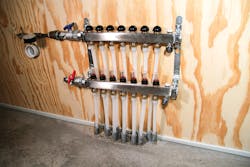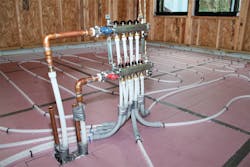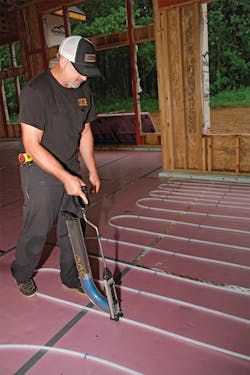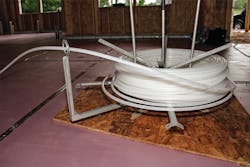Minnesota "Forever Home" Turns to PEX-Based Plumbing, Radiant Heating
AFTON, MN — Justin Johnson and his wife, Jessica, had been planning their “forever home” for five years when they decided in late 2019 that they were finally ready to begin construction. Johnson has worked as a union pipefitter in the plumbing and HVAC industries on a variety of commercial, industrial, and residential projects since the mid-1990s. Now, the 25-year industry veteran would have the opportunity to install many of the same comfort-enhancing and energy-efficient systems inside his new, 4,600-sq.-ft. home.
Construction began in the late spring of 2020. After an incredibly smooth building process, managed by Johnson—who also served as lead installer on the plumbing and heating systems—the couple moved in right before Thanksgiving in 2020.
“After using in-floor radiant heating on any number of projects for MMC and experiencing the comfort, efficiency, and health advantages of these
systems, I had to have radiant for our new home, no matter what,” says Johnson. “The elimination of dust and dry air through in-floor heating simply just makes for a healthier home.”
Johnson also knew — in somewhat of a departure for a home built in the northern United States — that he wanted the construction to be slab on grade, not the typical basement or crawl-space foundation. The radiant system featured Wirsbo hePEX™ tubing from Uponor — equipped with an oxygen barrier to prevent corrosion of ferrous system components. The install involved loops of tubing stapled down to foam insulation on the concrete slab. In addition, the heating system incorporated multiple zones throughout the structure, including the garage.
Radiant: Seven comfort zones
Created by Scott Hellendrung, lead design technician for the Uponor Construction Services team, the heating design called for segmenting Johnson’s floor plan into seven zones, each with its own manifold. The entire layout included 27 heating circuits. (There can be more than one PEX loop in a given zone.) The design featured the following zones in the home:
● Zone 1: Garage
● Zone 2: Bedroom #2, including bath, pantry, and hallway
● Zone 3: Bedroom #3
● Zone 4: Dinette, kitchen, foyer, office, great room
● Zone 5: Mud room
● Zone 6: Master bath, walk-in closet
● Zone 7: Master bedroom (#1)
Working with Hellendrung, Johnson shared his floor plan, the mapped-out heating zones, and all his heat-loss calculations. “Uponor Construction Services gave us everything we needed, including the accessories, and made it the easiest process,” Johnson says. “I felt well-prepared for the installation after that.”
The in-floor radiant installation process, involving nearly 5,500 feet of Wirsbo hePEX tubing, spanned two days, with Johnson and an MMC colleague doing all the work. On the first day, they completed the main floor of the home, which measured approximately 2,450 sq. ft.; the second day included the 1,800-sq.-ft. garage.
They arranged the tubing in the usual serpentine fashion and stapled it to 2" R-10 polystyrene foam. Once in place, they air tested the PEX and then filled the system with a 50% glycol solution heated to a set point of 117°F by a wall-hung, 110,000-Btu condensing boiler equipped with a 50-gallon storage tank.
Johnson feels so strongly about radiant technology and its benefits, he added it to other areas on his property as well. The glycol solution runs through a heat exchanger to heat a snow-melt system outside the home, and his detached, 2,000-sq.-ft. barn features a separate radiant heating system.
Supplementing the radiant system are two furnaces — one on the main floor and one directly above the garage — for those exceptionally frigid Minnesota winter days. Both units feature humidifiers, and an air exchanger is nearby as well.
The setup serves as a dedicated outdoor air system, designed to bring outdoor air into the home and remove contaminants, allergens, viruses, etc. According to Johnson, “I leave the fan on at low speed just in case the humidity levels need to be corrected.”
Plumbing: Benefits of recirculation
A small expansion tank with a pressure transducer monitors household water pressure. The pump changes speed in response to pressure changes, which are a function of water demand in the home. For example, if the family is using multiple faucets at once, the pump will accelerate to maintain the desired pressure of 60 psi. In general, the more outlets operating, the more likely the pump will run.
Kou Vang, also a lead design technician with Uponor Construction Services, designed the plumbing system in a trunk-and-branch layout. The design involved approximately 800 feet of Uponor AquaPEX® in diameters from ½" to 1¼" and featured hot-water recirculation, which was another priority amenity for Johnson. Once again, extra comfort, efficiency, and health were the drivers.
The recirculation system consisted of a single circulator with two balancing valves to control the gallons per minute (GPM) to each circuit for the hot water re-circulator and a pair of ½" recirculation lines: one serving the east side of the house and the other serving the west side. A timer governs the recirculation system to move warm water to the various outlets on either side, based on household usage patterns. The water circulates seven hours daily in three time slots: 4 to 8 a.m., 3 to 5 p.m., and 10 to 11 p.m.
“With the half-inch recirculation line, it’s always instant hot water,” says Johnson, explaining the benefits. “The fact that hot water is not constantly circulating means increased efficiency, because no heat is wasted.” Hot-water recirculation also reduces waste on potable water — as well as the energy used to heat it — while waiting for hot water to arrive at the tap.
One of the advantages of PEX is the option to design the pipe with higher flow velocities than copper and CPVC pipe. This allows plumbers to replace size for size despite the smaller inside diameter (I.D.). The smaller I.D. in PEX generates faster water delivery: 15% faster than a same-sized CPVC system and 30% faster than copper. According to the calculations by Uponor Construction Services, Johnson’s trunk-and-branch system would save roughly three-quarters of a gallon of water using PEX versus CPVC and 1.7 gallons versus copper. In other words, that’s how much less water would be lost down the drain every time the fixtures farthest from the water heater called for hot water.
“Besides offering a higher flow velocity compared to CPVC or copper, a PEX system holds a smaller volume of water than the same-sized system using either of these materials in the same pipe diameters,” explains Justin Churchill, residential segment manager, at Uponor. “As a result, Johnson’s household should cycle through that water more quickly. Faster cycling means less water sitting in the line for extended periods. That, in turn, reduces the chances for contaminants and bacteria growing in the system.”
Or, as Johnson sums it up: “This is another key part of the healthy ‘forever home’ we were aiming to build.”
A forever home
What is Johnson’s favorite part about his new home? “Where do I start?” he asks.
Well, how about comfort?
“Coming home, slipping off your boots, and walking across the warm floor after a long day’s work is the best. All of our Minnesota neighbors take immediate note of that, too, when they are visiting.”
Another cherished aspect is better health: “Knowing that our home has cleaner air is a big positive,” he continues. “In my experience, this is becoming a major homeowner demand. They want better indoor air quality. Different and thicker filtrations and cleaner air are high values in home building right now, and radiant systems can help supply it.”
Project Profile | Johnson Residence
Location
Afton, Minn.
Project highlights
● Slab-on-grade construction
● Total area under roof: 4,593 sq. ft.
● 100,000 Btu/hr heating load | R-40 ceiling, R20 walls, R10 floor
● Radiant installation: Staple down for both the home and the garage
● Plumbing installation: Trunk and branch
● Well system uses a booster pump to generate water pressure of 60 psi
● Recirculation line installed with a recirculation pump to reduce hot-water delivery times, eliminate water waste, and prevent water stagnation
● All hot-water and recirculation lines insulated to meet ASHRAE 90.1
Products used
● Plumbing: 800 feet of Uponor AquaPEX® ranging from ½" to 1¼" with 148 fittings featuring Uponor ProPEX® connection system
● Radiant heating: 5,462 feet of Wirsbo hePEX™ | 186 fittings | 7 stainless-steel manifolds controlling 27 heating circuits




